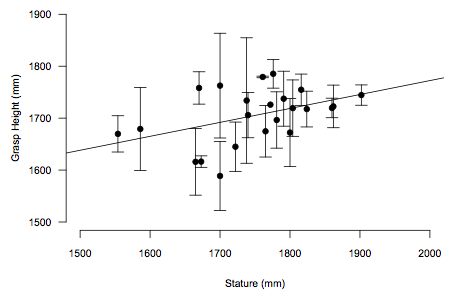Findings
Hand Locations in Ingress
Reed, M.P., Hoffman, S.G., and Ebert-Hamilton, S.M. (2010). Hand positions and forces during truck ingress. Proceedings of the 2010 Human Factors and Ergonomics Society Annual Meeting. HFES, Santa Monica, CA.
Objective: Quantify the location of right-hand grasp on the exterior or interior handhold at the start of ingress. This is an important variable used to determine handhold placement and dimension
Method: The right-hand palm center location was calculated from optical markers on the back of the hand. Hand position during this phase of the ingress event was quantified by the height of the palm center above the ground.
Results: Grasp height above the ground on the external handhold was approximately normally distributed with a mean (standard deviation) of 1720 (114) mm. The figure shows the within-subject mean and stature deviation of grasp height as a function of driver stature for trials with the external handhold. A linear regression analysis on subject means showed that mean grasp height was significantly but weakly related to stature (674 + 0.599 Stature, p<0.01, R2 = 0.31, RMSE = 72 mm). The mean within-subject grasp height was equal to 99 percent of stature (s.d. 4% of stature). For all subjects, the mean grasp height on the external handle was between 90% and 110% of stature.
For the internal handle, the mean grasp height was 1705 (79) mm. The stature relationship was not significant (p>0.01), probably because of the restriction in the range of the dependent measure imposed by the relatively short handle.
Key Findings:
• Driver right-hand position during the initial phase of ingress is not strongly related to body size.
• Human-model-based analyses should assume a range of postures rather than the same posture for short and tall drivers.

©2017 University of Michigan